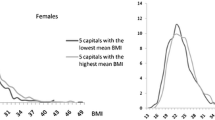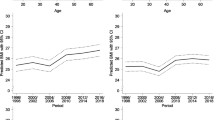Abstract
Aim
Obesity is a public health problem, and all high-, low- and middle-income countries face it worldwide. The purpose of this study was to investigate the epidemiology of obesity and its relation to the Human Development Index in Asian countries in 2016.
Subjects and methods
This is an ecological study. The data required were the HDI and the prevalence of obesity (BMI ≥ 30) in adults > 18 years of age, obtained from the World Bank (https://data.worldbank.org/). Two-way correlation and analysis of variance were used at a significance level < 0.05, and the analyses were performed using Stata-14 software.
Results
Between 2000 and 2016, the highest prevalence of obesity was found for males and females > 18 years living in the American and the lowest was found for those in Southeast Asia. The results showed that there was a positive and significant correlation between the prevalence of obesity in males (r = 0.486, P < 0.001) and females (r = 0.360, P < 0.001) with the HDI. The study of HDI components showed that there was a positive and significant correlation between the prevalence of obesity with GNI (r = 0.429, P < 0.01), MYS (r = 0.343, P < 0.01), LEB (r = 0.332, P < 0.001) and EYS (r = 0.331, P < 0.001). However, the correlation was not significant for the prevalence of obesity with GNI, MYS, LEB and EYS (P > 0.05). The highest mean prevalence of obesity in males (20.6 ± 11.8) and in females (26.3 ± 16.2) was linked to a very high human development index.
Conclusion
According to the results, the prevalence of obesity among males and females in the Asian continent is higher in countries with a high HDI, indicating the presence of obesity-related factors in these countries. Therefore, attention to lifestyle and physical activity as risk factors for obesity can be effective in reducing the prevalence of obesity in these countries.



Similar content being viewed by others
References
Anand S, Sen A (1994) Human Development Index: Methodology and Measurement. pp182
Barich F, Zahrou FE, Laamiri FZ, El Mir N, Rjimati M, Barkat A, Aguenaou H (2018) Association of obesity and socioeconomic status among women of childbearing age living in urban area of Morocco. J Nutr Metab 20(18):312. https://doi.org/10.1155/2018/6043042
Blundell JE, Baker JL, Boyland E, Blaak E, Charzewska J, De Henauw S, Holm L (2017) Variations in the prevalence of obesity among European countries, and a consideration of possible causes. Obes Facts 10(1):25–37. https://doi.org/10.1159/000455952
Boutayeb A, Boutayeb S, Boutayeb W (2013) Multi-morbidity of non communicable diseases and equity in WHO eastern Mediterranean countries. Int J Equity Health 12(1):60
Chang VW, Lauderdale DS (2005) Income disparities in body mass index and obesity in the United States, 1971-2002. Arch Intern Med 165(18):2122–2128
Correa MM, Thume E, De Oliveira ERA, Tomasi E (2016) Performance of the waist-to-height ratio in identifying obesity and predicting non-communicable diseases in the elderly population: a systematic literature review. Arch Gerontol Geriatr 65(2):174–182. https://doi.org/10.1016/j.archger.2016.03.021
Dinsa GD, Goryakin Y, Fumagalli E, Suhrcke M (2012) Obesity and socioeconomic status in developing countries: a systematic review. Obes Rev 13(11):1067–1079. https://doi.org/10.1111/j.1467-789X.2012.01017.x
Fillol F, Dubuisson C, Lafay L, Dufour A, Bertin M, Touvier M, Lioret S (2011) Accounting for the multidimensional nature of the relationship between adult obesity and socio-economic status: the French Second National Individual Survey on Food Consumption (INCA 2) dietary survey (2006–07). Br J Nutr 6(10):1602–1608. https://doi.org/10.1017/S0007114511002030
Jeffery RW, French SA (1996) Socioeconomic status and weight control practices among 20-to 45-year-old women. Am J Public Health 86(7):1005–1010. https://doi.org/10.2105/AJPH.86.7.1005
Kohl HW 3rd, Craig CL, Lambert EV, Inoue S, Alkandari JR, Leetongin G, Group LPASW (2012) The pandemic of physical inactivity: global action for public health. Lancet 380(9838):294–305. https://doi.org/10.1016/S0140-6736(12)60898-8
Lee H, Harris KM, Gordon-Larsen P (2009) Life course perspectives on the links between poverty and obesity during the transition to young adulthood. Popul Res Policy Rev 28(4):505. https://doi.org/10.1007/s11113-008-9115-4
Lee IM, Shiroma EJ, Lobelo F, Puska P, Blair SN, Katzmarzyk PT, Group LPASWs (2012) Effect of physical inactivity on major non-communicable diseases worldwide: an analysis of burden of disease and life expectancy. Lancet 380(9838):219–229. https://doi.org/10.1016/S0140-6736(12)61031-9
Marck CH, Neate SL, Taylor KL, Weiland TJ, Jelinek GA (2016) Prevalence of comorbidities, overweight and obesity in an international sample of people with multiple sclerosis and associations with modifiable lifestyle factors. PLoS One 11(3):e0148573. https://doi.org/10.1371/journal.pone.0148573
Marques A, Peralta M, Naia A, Loureiro N, de Matos MG (2017) Prevalence of adult overweight and obesity in 20 European countries, 2014. Eur J Pub Health 28(2):295–300. https://doi.org/10.1093/eurpub/ckx143
Mesters I, Wahl S, Van Keulen HM (2014) Socio-demographic, medical and social-cognitive correlates of physical activity behavior among older adults (45–70 years): a cross-sectional study. BMC Public Health 14(1):647. https://doi.org/10.1186/1471-2458-14-647
Mitchell S, Shaw D (2015) The worldwide epidemic of female obesity. Best Pract Res Clin Obstet Gynaecol 29(3):289–299
Ng M, Fleming T, Robinson M, Thomson B, Graetz N, Margono C, Abera SF (2014) Global, regional, and national prevalence of overweight and obesity in children and adults during 1980–2013: a systematic analysis for the global burden of disease study 2013. Lancet 384(9945):766–781. https://doi.org/10.1016/S0140-6736(14)60460-8
Obesity W (2000) Preventing and Managing the Global Epidemic. Report of a WHO consultation. Geneva: World Health Organization (3):358
Pigeyre M, Rousseaux J, Trouiller P, Dumont J, Goumidi L, Bonte D, Amouyel P (2016) How obesity relates to socio-economic status: identification of eating behavior mediators. Int J Obes 40(11):1794. https://doi.org/10.1038/ijo.2016.109
Prentice AM (2005) The emerging epidemic of obesity in developing countries. Int J Epidemiol 35(1):93–99. https://doi.org/10.1093/ije/dyi272
Saito Y, Oguma Y, Inoue S, Tanaka A, Kobori Y (2013) Environmental and individual correlates of various types of physical activity among community-dwelling middle-aged and elderly Japanese. Int J Environ Res Public Health 10(5):2028–2042. https://doi.org/10.3390/ijerph10052028
World Health Organization, O. a. O. World Health Organization, Geneva, Switzerland, 2018. http://www.who.int/mediacentre/factsheets/fs311/en/
Author information
Authors and Affiliations
Corresponding author
Ethics declarations
Conflict of interest
The authors report no conflict of interest.
Additional information
Publisher’s note
Springer Nature remains neutral with regard to jurisdictional claims in published maps and institutional affiliations.
Rights and permissions
About this article
Cite this article
Khazaei, Z., Sohrabivafa, M., Darvishi, I. et al. Relation between obesity prevalence and the human development index and its components: an updated study on the Asian population. J Public Health (Berl.) 28, 323–329 (2020). https://doi.org/10.1007/s10389-020-01230-1
Received:
Accepted:
Published:
Issue Date:
DOI: https://doi.org/10.1007/s10389-020-01230-1




